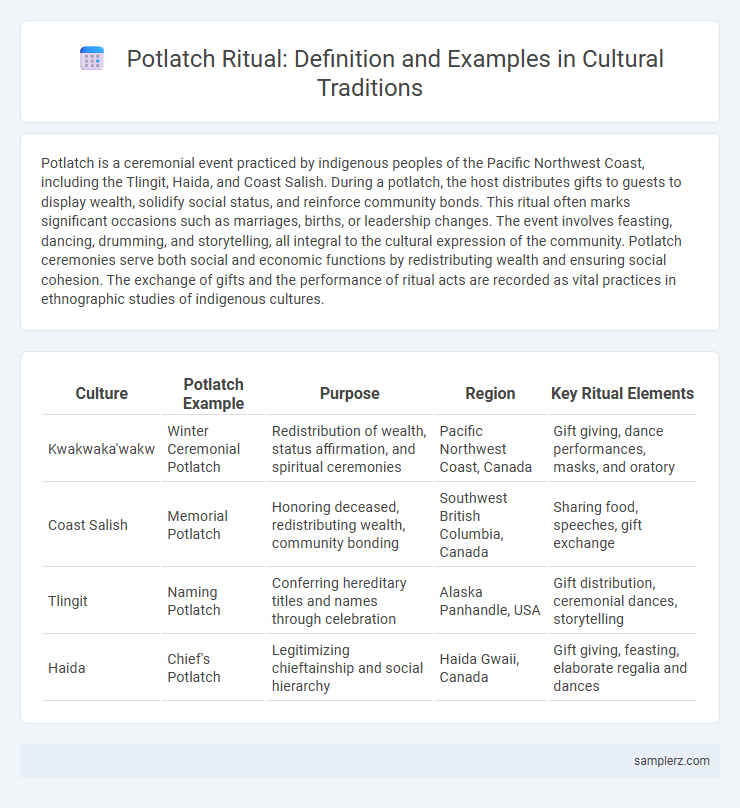Potlatch is a ceremonial event practiced by indigenous peoples of the Pacific Northwest Coast, including the Tlingit, Haida, and Coast Salish. During a potlatch, the host distributes gifts to guests to display wealth, solidify social status, and reinforce community bonds. This ritual often marks significant occasions such as marriages, births, or leadership changes. The event involves feasting, dancing, drumming, and storytelling, all integral to the cultural expression of the community. Potlatch ceremonies serve both social and economic functions by redistributing wealth and ensuring social cohesion. The exchange of gifts and the performance of ritual acts are recorded as vital practices in ethnographic studies of indigenous cultures.
Table of Comparison
| Culture | Potlatch Example | Purpose | Region | Key Ritual Elements |
|---|---|---|---|---|
| Kwakwaka'wakw | Winter Ceremonial Potlatch | Redistribution of wealth, status affirmation, and spiritual ceremonies | Pacific Northwest Coast, Canada | Gift giving, dance performances, masks, and oratory |
| Coast Salish | Memorial Potlatch | Honoring deceased, redistributing wealth, community bonding | Southwest British Columbia, Canada | Sharing food, speeches, gift exchange |
| Tlingit | Naming Potlatch | Conferring hereditary titles and names through celebration | Alaska Panhandle, USA | Gift distribution, ceremonial dances, storytelling |
| Haida | Chief's Potlatch | Legitimizing chieftainship and social hierarchy | Haida Gwaii, Canada | Gift giving, feasting, elaborate regalia and dances |
Understanding Potlatch: Ritual Origins and Meaning
Potlatch is a ceremonial feast practiced by Indigenous peoples of the Pacific Northwest, including the Kwakwaka'wakw and Tlingit, where hosts redistribute wealth and assert social status through gift-giving. Rooted in complex social, economic, and spiritual traditions, potlatch functions as a means of reinforcing community bonds, validating leadership, and marking significant life events such as births, marriages, and funerals. Understanding potlatch requires recognizing its role in resource exchange, social hierarchy, and the maintenance of cultural identity within these Indigenous societies.
Key Elements of Potlatch Ceremonies
Potlatch ceremonies prominently feature gift-giving as a central element, symbolizing wealth distribution and social status reinforcement within Indigenous Northwest Coast communities. Elaborate feasting and performance of traditional songs and dances strengthen communal bonds while honoring ancestral spirits. The ceremonial exchange and display of regalia, such as masks and carved cedar boxes, serve as tangible representations of lineage and cultural heritage.
Notable Historical Potlatch Events
The 1885 potlatch on the northwest coast, led by the Kwakwaka'wakw chief, marked a significant cultural assertion against Canadian government bans on Indigenous ceremonies. The 1921 potlatch at Alert Bay, despite legal prohibitions, showcased resilience through grand feasting and gift-giving that reinforced social status and communal bonds. These events highlight potlatch as pivotal in preserving Indigenous identity and challenging colonial restrictions.
Gift-Giving Practices in Potlatch Rituals
Potlatch rituals exemplify intricate gift-giving practices central to Indigenous cultures of the Pacific Northwest, where hosts distribute lavish gifts to assert status and reinforce social bonds. These ceremonies involve the exchange of valuable items such as blankets, copper shields, and food, symbolizing wealth redistribution and community solidarity. Gift-giving in potlatch serves both as a social obligation and a means to affirm identity, prestige, and reciprocal relationships within the tribe.
The Role of Community in Potlatch Traditions
Potlatch traditions play a crucial role in strengthening community bonds through ritualized gift exchanges that affirm social status and facilitate the redistribution of wealth. These ceremonies, practiced by Indigenous peoples of the Pacific Northwest, serve as a platform for affirming kinship ties, resolving disputes, and reinforcing collective cultural identity. The communal participation in potlatch rituals ensures the transmission of values and social responsibilities, fostering unity and mutual support within the group.
Symbolic Objects Exchanged during Potlatch
During potlatch ceremonies, symbolic objects such as intricately carved wooden masks, ceremonial blankets, and elaborately decorated bentwood boxes are exchanged to convey status and social ties. These items represent the wealth and generosity of the host, reinforcing communal bonds and cultural identity among the Indigenous peoples of the Pacific Northwest. The exchange of such objects serves both as a display of prestige and as a means to redistribute resources within the community.
Seasonal Timing and Potlatch Rituals
Potlatch rituals are meticulously timed to coincide with specific seasonal cycles, often during late winter or early spring when communities prepare for new growth and renewal. These ceremonies serve as social and economic events where wealth is redistributed through gift-giving, reinforcing social status and communal bonds. The timing aligns with subsistence activities, ensuring resources accumulated during hunting and fishing seasons are shared to sustain the community throughout the year.
Storytelling and Oral Histories in Potlatch
Potlatch ceremonies, practiced by Indigenous peoples of the Pacific Northwest, feature storytelling as a vital ritual component, preserving oral histories and cultural values across generations. These narratives often include clan legends, ancestral exploits, and moral lessons, reinforcing social bonds and collective identity within the community. Through eloquent oratory and symbolic gift-giving, potlatch participants transmit knowledge and maintain the continuity of their heritage.
Modern Revivals of Potlatch Ceremonies
Modern revivals of potlatch ceremonies among Indigenous communities on the Northwest Coast emphasize cultural resilience and intergenerational knowledge-sharing. These contemporary gatherings often blend traditional practices with new artistic expressions, reinforcing collective identity and social cohesion. Governments and cultural organizations increasingly support these events to revitalize language, customs, and Indigenous governance systems.
Potlatch and Cultural Identity Preservation
Potlatch ceremonies serve as vital rituals for Indigenous communities, reinforcing social bonds and cultural identity through the exchange of gifts and the affirmation of status. These gatherings preserve languages, oral histories, and traditional customs, ensuring the transmission of cultural heritage across generations. By actively practicing potlatch, communities resist cultural assimilation and maintain sovereignty over their ancestral narratives and social structures.

example of potlatch in ritual Infographic
 samplerz.com
samplerz.com